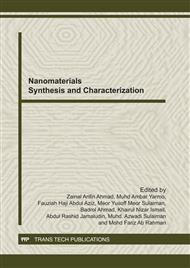p.100
p.105
p.110
p.115
p.119
p.124
p.129
p.134
p.139
Effect of R.F Power to the Properties of ZnO Thin Films Deposited by Magnetron Sputtering
Abstract:
The effect of radio frequency (R.F) power to the properties of zinc oxide (ZnO) thin films deposited by magnetron sputtering is presented. This project has been focused on electrical, optical and structural properties of ZnO thin films. The effect of variation R.F power at 100 watt ~ 400 watt on the ZnO thin films has been investigated. The thin films were examined using current-voltage (I-V) measurement, UV-Vis-NIR spectrophotometer, x-ray diffraction (XRD) and atomic force microscope (AFM). ZnO thin films were prepared at room temperature in pure argon atmosphere by a R.F magnetron sputtering using ZnO target. I-V measurement indicates that at 300 watt R.F power show the highest conductivity. All films have showed high UV absorption properties using UV-VIS spectrophotometer (JASCO 670). Highly oriented ZnO thin films [002] direction was obtained by using Rigaku Ultima IV. The root means square (rms) roughness for ZnO thin film were about (<2nm) was measured using AFM (Park System XE-100). Keywords-ZnO thin films, R.F power, electrical properties, optical properties, structural properties
Info:
Periodical:
Pages:
119-123
Citation:
Online since:
October 2011
Authors:
Price:
Сopyright:
© 2012 Trans Tech Publications Ltd. All Rights Reserved
Share:
Citation:


